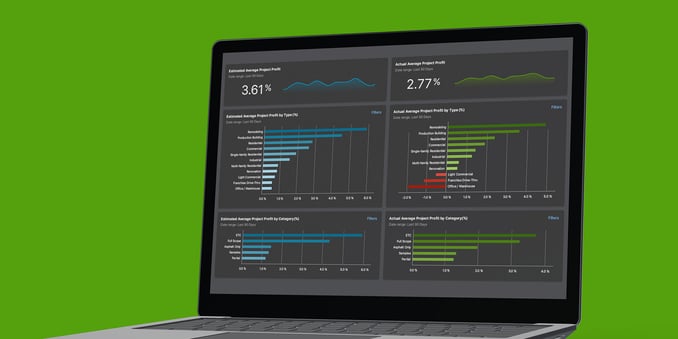Accurately measuring the success of a construction project can be difficult if you don’t know what to look for, especially when there are so many different aspects of a construction project to manage.
Here are a few key performance indicators that can help you in determining whether or not your construction projects are succeeding, as well as some specific ways you can ensure each of those factors are accurately being measured:
1. Profitability
The end goal of the construction business is to make money. If your construction projects aren’t consistently making a profit, this may indicate some major problems in your business’ project management, which ultimately hurts project success.
Tracking Gross and Net Profit
For more accurate profitability metrics, keep track of both gross and net profit margins.
Gross profit is the amount of money made after subtracting the cost of goods sold (COGS), including materials and labor, from total revenue. This is calculated by subtracting the COGS from your total sales.
Net profit is the amount of money made after deducting all operating costs - like office expenses, insurance, payroll, and overhead - interest, and tax expenses from gross profit over a given period of time. If the value of net profit is negative, then it’s called a net loss.
Actuals vs. Estimated Profits
In addition to tracking gross and net profit margins, keeping track of estimated and actual profits can give you more complete insight into project financial data.
Tracking both allows you to see where you might be overspending or incorrectly tracking changes to the budget, including change orders, client selections, and more.
To ensure project success, you’ll want to closely track your company's gross and net profit margins and actual vs. estimated profits, and make sure all relevant team members have easy access to this information.
Want to see how your current projects stand financially? Check out our Free Project Health Template that will show how you're doing in various areas of each of your construction projects, including finances, scheduling, communication, and more.
2. Tracking Finances
Tracking project finances goes hand-in-hand with profitability in terms of tracking project success, but it involves a little more than just tracking profit margins. It involves knowing the ins-and-out of how finances are being managed, including the total amount of pending and approved change orders, changes in the budget, a detailed breakdown of costs, and whether your project finished under or over budget.
Using Financial Reports to Stay on Track
One efficient way to track cash flow is to use financial reports. You can utilize job costing reports to track budgets and measure project profitability.
Financial reports allow you and your team to see the different financial aspects of your project in detail, such as the variance between total estimated costs and actuals, or summaries for change orders, client selections, and purchase orders, all of which can give you a comprehensive breakdown of project finances.
Getting a Comprehensive View of Finances with Financial Dashboards
Tracking finances can get really dicey if you don’t have an efficient way of keeping an eye on every aspect of project finances, especially if you’re using multiple software platforms.
Having one centralized way of viewing financial details, such as a dashboard, can give you and your team a centralized view of your project finances, including how much money is coming and going, where you are losing money, and ultimately protecting your bottom line.
To ensure project success, make sure you intimately know how finances are being handled throughout a project’s progression.
3. Timeline of Completion
Whether or not your team is finishing tasks on time is another key indicator of project success. Setting daily and weekly deadlines and meeting crucial milestones are just a few ways you can make sure your project stays on track and stays on budget.
Creating Critical-Path Schedules to Keep Projects on Track
The critical path technique is a method of identifying key tasks, or milestones, over the course of a project to ensure that you complete tasks on a schedule.
Critical-path schedules make planning for your construction project more effective. They also help you to more efficiently reallocate resources when facing unexpected delays or additional tasks. For instance, if a task has been delayed because of a weather condition, you will be able to see how that change in the schedule affects the rest of your project timeline.
Create Project Baselines to View Where Your Schedule Stands
A project baseline is a fixed reference point used to compare project performance over time. Creating baselines for your construction project is crucial to keeping projects on track with your schedule, and helping you to manage time more wisely by viewing where you are gaining or losing time.
Your time is money, so keep close track of how time is being managed among your team members to ensure project success. Learn about how you can create critical-path schedules and baselines for your construction projects with ease using ConstructionOnline™.
Want to see how well communication in your project is going? Check out our Free Project Health Template that will show how you're doing in various areas of each of your construction projects, including communication, finances, scheduling, and more.
4. Team Performance and Efficiency
Making sure all team members know what is expected of them and keeping everyone in the loop on project details is key to ensuring your projects are running efficiently and successfully.
When your team members are unclear on their roles in a project, it can cause a host of problems, including delays in your schedule, deadlines having to be pushed back, and money being lost, all of which will ultimately harm a project’s success. It’s crucial to keep team members informed every step of the way so that your team can perform at its best.
Creating Daily, Weekly, and Monthly Deadlines for Team Members
One effective way of keeping your team informed is to give each team member a list of project activities they are responsible for completing daily, weekly, bi-weekly or monthly.
This ensures everyone knows what to do, and when to do it so that your project stays on schedule.
ConstructionOnline™ GamePlan is the perfect tool for automating this process; it allows your project managers to send out calendar events to the relevant team members automatically at a chosen time interval, which vastly improves communication among team members.
Know Where and When Your Team is Working with Daily Logs
Maintaining daily project records of how your team manages time and resources is key to making sure your project runs efficiently.
You can use daily logs to keep track of who has completed what tasks, why certain tasks have been delayed, and what still needs to be done so that your project managers have daily records of how time and resources are being spent, both on and off the jobsite.
To make sure your team is running at peak efficiency, it’s important that team members know what they are supposed to do at all stages of the project, and it’s important that your project managers have a systematic way of seeing what each team member has done, every day.

5. Client Satisfaction and Meeting Client Expectations
It’s hard to call your project a success if your clients aren’t satisfied with the end product. This is why it’s crucial for you to set unambiguous financial expectations with your client, and to keep clients in the loop about any changes to the project and the budget, so that there are no surprises at closeout.
Using Estimate Proposals to Set Project Expectations
You can utilize proposals to give your client a detailed breakdown of what to expect as far as finances are concerned, so there are no questions left unanswered.
Giving your client an accurate proposal removes any ambiguity about project finances so that when it comes time to send that final invoice, your client has no hesitation to pay up, and you cover yourself from any potential legal issues.
Creating Change Orders for Clear Communication About Changes to the Budget
When changes to your project inevitably happen, it’s important for your client to know about them ASAP, so they aren’t blindsided about changes to the proposed budget further in the project timeline.
In a construction project, anything can happen. That’s why when unexpected changes occur, you need to have a systematic way of creating and sending your client change orders, allowing your client to approve or reject them, and viewing how approved change orders affected the initial estimate.
By giving your client clear expectations about the project finances upfront and keeping them in the loop about changes to the project using change orders, you can ensure your clients walk away satisfied with the end result while also avoiding any potential legal hassle that may come with an unhappy client.
6. Comprehensive View of Overall Project Performance
Measuring the individual indicators that we’ve discussed thus far is a great way of measuring the success of different aspects of your project.
What’s even more effective is viewing a complete analysis of all the different success indicators - including financials & profitability, timeline completion, and team performance & efficiency - in one centralized place. This way, you won’t have to manually piece together segmented project data to get a complete understanding of how your project performed.
Want to learn how you can keep up with the success indicators of multiple projects at once? Check out our article How to Manage Multiple Construction Projects Simultaneously.
View Your Project Data in a Dashboard or Spreadsheet for a Combined View
One way you can get an overall view of project performance is to put the individual success indicator data into a dashboard or spreadsheet.
By combining the metrics into a dashboard, you can view the data in one centralized place, and you can more easily compare and contrast the different areas of performance, giving you and your team a more accurate measurement of overall project success.
This solution does require a little more work on your part since you would need to manually enter the data after each project, and comparing project data over time to see how your company’s success has progressed throughout the years gets more complicated, but it’s well-worth the effort.
Get a Company-Wide View of Project Performance
A more streamlined way of viewing combined project data is to use a tool that is built for this specific purpose, such as TrueVision™ Business Intelligence, rather than calculating and manually entering in all of that data yourself.
With TrueVision™ Business Intelligence, you can view your project data the way it was meant to be viewed - holistically instead of as disconnected parts.
You can see which jobs are under-or overperforming, track budgets and profitability, identify and mitigate risks, track your schedule’s progress, and more - all in one combined Project Scorecard. This gives you and your team a bird’s-eye view of how projects are performing.
You can also view a comparison of past projects, so that you and your team can see how your track record has improved, or declined, over the years.
By viewing all of the success indicators in one centralized place where project data can be compared and contrasted, your team can get the ultimate and most accurate measurement of project success.
Accurately measuring project success is easier than ever with the amount of digital tools contractors can use now. If you want to learn more about how technology can help your construction business, check out our article The Importance of Using Technology in Tech.




.png?width=230&name=uda_renew_logo%20(1).png)



